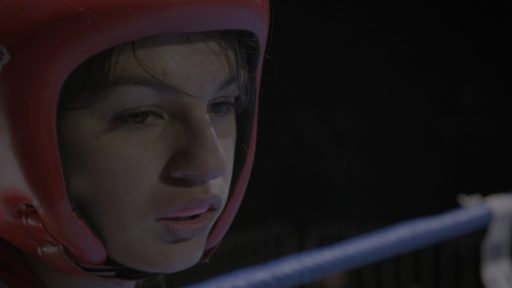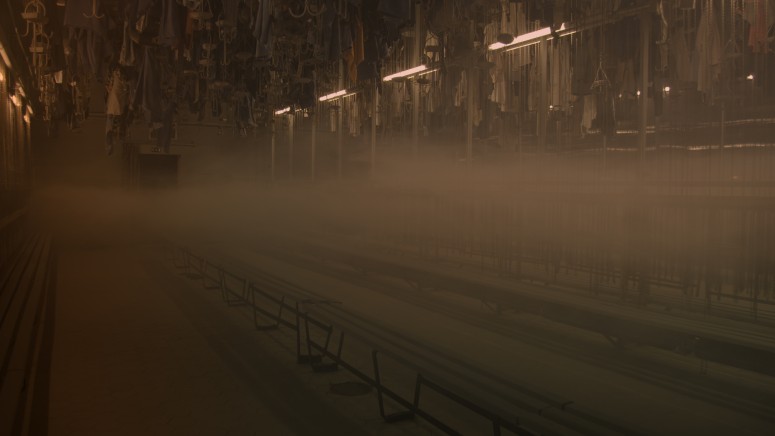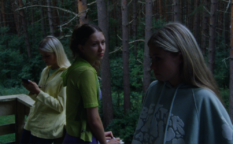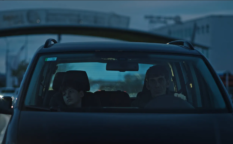Review: Strike or Die (2020)

A deserted city at nighttime. Wafts of mist rising in the distance, creeping slowly through the air, as they block the saturated yellow light of the streetlights and engulf their surroundings in an impenetrable wall. A humming background noise intensifies with a slow crescendo, as the eery flute music accentuates the pockets of mist filling out the screen. Something has happened here. A memory is wailing its silent tune.
These are chilling pictures, with which French director Jonathan Rescigno feeds his first feature-length film. After prior short films and video installations that have dealt with social realities in his home region Grand Est at the French-German border, this time one cinematic eye turns to the miner’s strike of 1995. Commencing in November of 1995, the public sector all over France fought Jacques Chirac’s plans to change the pensions of workers and cut essential funding. Lasting until December the same year, the strike was so popular amongst hundreds of thousands of workers, it brought the country’s infrastructure to a hold.
The other eye observes the local community in the present day with its daily routines, hopes, and problems. Rescigno follows two young men of Algerian descent, as they enjoy themselves at the local fair, take up boxing or talk about their future and the challenges in a society with double standards for people with an immigrant background. Then there is an old former miner, carefully sorting his historic collection of tear gas grenades, picks, and helmets, decorated with dates of strikes and number of injured, in a box labeled 1995. He will later donate these reminiscences of past days to the mining museum. Another man is dealing with the complicated situation of his boss lying in an insurance report. Just like the miners, his healthcare is in jeopardy and his pension threatened. His wife, who won’t let this injustice slide, starts mentoring him to stand up to the authorities. The final protagonist is a boxing trainer, who keeps pushing his pupils to give their best, feeding them with lines such as “Willpower is half the battle”.
The stories are not only interconnected by the mystical fog that keeps pushing itself into the frame as human interactions fade from the screen, but also by the narrative structure that slowly starts to converge. Relationships are unveiled, shared experiences highlighted. This development is intercut with archive footage of the strikes. In noisy and pixelated video recordings, a cluster of miners is moving down the streets with banners, so much in contrast to the empty and memory haunted alleys of modern-day. Grenades are thrown, barricades are built, glass doors, behind which officials are crouching, are stormed. At the center of it that white and grey smoke from the grenades rising in the air, perfectly mirroring this present-day fog, a cloudy soup of collective and blurred memories.
Rescigno doesn’t choose to comment on the issues of the past. Rarely do his characters. The choice of approach is to make the story a constant flow. A spiral of ever-repeating cycles of injustice, absence of economic prospects and challenges. A glimpse into this world with a distant lens. “They cried,” the wife exclaims as she keeps pushing her husband to stand up to his boss. “Losing the mines was like losing a colleague”. The struggle of the miners is ingrained in the locals’ consciousness, their legacy lives on.
The quiet, observative camerawork of DOP Hervé Roesch captures these raw moments of unfiltered livelihood as well as the artistic, strange aura of the city’s otherworldliness. The former miner CEO headquarter keeps popping up repeatedly like a monolith, a monument of silent memory. The distressing music by Manfred Miersch keeps the viewer in a constant uneasiness, working as a constant reminder of things dwelling underneath.
The film further pushes this symbiosis of past and present with the two young men visiting the mining museum. The museumization of memories and objects and the rediscovery of silent witnesses build a bridge between the artistic and historical approaches to the subject. Rescigno shows that the connection to the past does not only serve as a loop but as an identity creating moment. “It’s normal that our grandparents came here”, one of the boys happily exclaims, as they spot a sign about immigrant workers between old uniforms, lamps, and helmets.
This smart elliptic storytelling, the silent observation of those coming from the barricades and those tearing down new ones, provides the movie with multiple innuendos to modern life. Life goes on as it always has. The struggle will continue, even though it might be wearing a new face and reason. The present, Rescigno shows us, is always a variation of the past.
“Strike or Die” had its world premiere in the Forum section of the Berlinale on February 23rd.

Original title: Grève ou Crève
Country: France
Language: French
Runtime: 93 min.
Written and directed by: Jonathan Rescigno
Cinematography: Hervé Roesch
Editing: Jérôme Erhart
Music: Manfred Miersch
Sound Design: Jérôme Petit
Sound: Simon Apostolou
Producer: François Ladsous
















